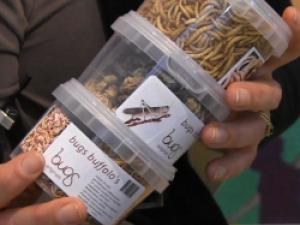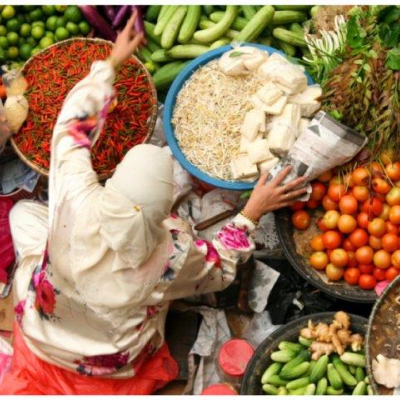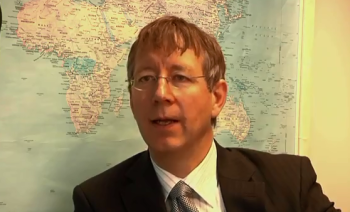Insects are rich in protein and ecologically sustainable to produce, so why are we reluctant to put them in our mouths? According to Marian Peters, chairperson of the Dutch Insect Breeders Association, the answer is partly cultural.
Europeans can produce insects but are reluctant to eat them, she said, while in many parts of the developing world a beetle snack is nothing strange but production remains limited.
Ms Peters appeared at a lunchtime conference held by EuropeAid’s Information Portal last month on the future of entomophagy, or ‘insect eating’.
An estimated two billion people eat insects as part of their normal diet, according to the United Nations Food and Agriculture Organisation (FAO), and about 2 000 species have been identified as edible.
Hesitation in Europe largely stems from the “yuck factor”, said Ms Peters, who is also chief executive of New Generation Nutrition, a company that has sold products such as mealworms, locusts and buffalo worms for six years.
“People are aware that you can eat them, but then there is the first step to take to put it in your mouth. That first time it’s difficult, and when you have tasted it afterwards you know it’s okay.”
Bugs can also be ground into a nutrient-rich powder and added to more conventional foods, such as pies and chicken nuggets. Ms Peters said research had shown consumers were less perturbed by this, provided the food was clearly labelled as including “insect protein”.
Expanding the use of insects as food, either for humans or as animal feed, may also have big implications for developing countries.
The high stakes are set out in an abstract for the ‘Insects to feed the world’ conference, to be held at Wageningen University in the Netherlands this May:
“FAO estimates that the world needs to increase its food production by 70 percent by 2050 in order to serve a global population of nine billion. Animal feed production is increasingly competing for resources (land, water and fertiliser) with human food and fuel production, urbanisation and nature. Seventy percent of the world’s agricultural land is already directly or indirectly dedicated to meat production. With a growing world population and increasingly demanding consumers, can we still produce sufficient animal protein in the future?”
A recent Guardian infographic shows one kilogram of termites provides 350g of protein, compared to 320g from one kilogram of beef. One kilogram of feed gives 470g of edible weight for crickets, but just 110g for pigs and 40g for cows. A much greater proportion of an insect’s body is edible.
Ms Peters is behind the Flying Food project in Kenya and Uganda, training farmers to set up small-scale rearing stations to produce crickets all year round. These nutritious insects are already caught in the wild each season, but by 2017 Flying Food (which is largely sponsored by the Dutch government) aims to train 4 000 farmers to produce and sell 55 000kg of crickets each year.
If everyone on earth switched to eating insects up to 30 percent of the world’s land surface could be reclaimed from livestock, 18 percent of green house emissions could be eliminated and 33 percent could be cut from average food prices in most countries.
That’s not going to happen, even though people in the Central African Republic eat an average of 42 caterpillars per day during the rainy season. Ms Peters acknowledges that insect production is likely to make its biggest contribution in the form of feed for other animals.
She said some farmers in the Flying Food project were already producing fatter chickens that lay bigger eggs by feeding them insects.
Meanwhile, in the Western world, Professor Joop van Loon from Wageningen University said there are three obstacles to the adoption of insects as food: reluctant consumers, the relatively high cost of production (particularly labour costs), and regulatory requirements.
Ms Peters outlined some of the restrictions facing insect famers in the Netherlands.
Since some insects are classified as a “production animal” farmers are not allowed to use organic waste as feed, which drives up costs.
There are 29 species of insect on the list of production animals, but 63 species are farmed. Ms Peters said more must be done to bring species now being reared illegally onto the list of production animals.
And under Dutch law insects cannot be slaughtered on the farm.
“That’s a technical issue,” she said. “How to kill them? Where to kill them? So new law or regulations have to be made. We’d like to make them also in all sorts of discussions and communications with you here at European level.”
Chantal Bruetschy, Head of Unit for "innovation and sustainability" at the European Commission's Directorate General for Health and Consumers (SANCO), responded by suggesting that confirmation of food safety would probably contribute to consumer confidence and broader market acceptance in developed countries.
She said that there is potential for entomophagy to assist developing countries due to the efficient feed conversion rate and the high protein deficit in certain countries.
In Europe itself, SANCO and the European Union Member States have discussed whether insects fall under the Novel Food legislation*, which obliges companies to submit an application, including a risk assessment, before putting a new product on the market.
One of the criteria used to determine whether a food should be considered “novel” in Europe is the level of consumption.
“Member States have had difficulties in gathering the data,” Ms Bruetschy said. “The results so far are that there is limited consumption. Based on the discussions we have had at a working level with Member States so far, it would seem that they fall under the Regulation and would go through an authorisation procedure.” This will require further discussion with the Member States.
She also said that much research is ongoing and that some scientific studies refer to the possible presence of residues (plant protection products or heavy metals) in insects, depending on which feed they are grown.
Professor Van Loon said there was not much information about how insects deal with toxins in the plants they eat, though he said crickets feed on a variety of plants and have their own detoxification system.
However, insects may also ingest extremely toxic compounds such as those found on microbial growth in waste products. Professor Van Loon said “there is not a lot of information on how insects detoxify those and if they detoxify them for themselves if they don’t produce toxins that are still dangerous for us.
Given the potential benefits in Europe and around the world Ms Bruetschy said SANCO supported entomophagy, provided there were proper safeguards.
“The title of my unit is innovation and sustainability, so we go in favour of it,” she said, “[but] we think that innovation cannot go at the price of food safety.”
You can find more information about this event and download a copy of Ms Peters presentation in the Food & Nutrition Security - ROSA group.
This collaborative piece was drafted with input from Chantal Bruetschy and Andrea Massarelli with support from the capacity4dev.eu Coordination Team. Teaser image courtesy of Peter Halasz.







Log in with your EU Login account to post or comment on the platform.